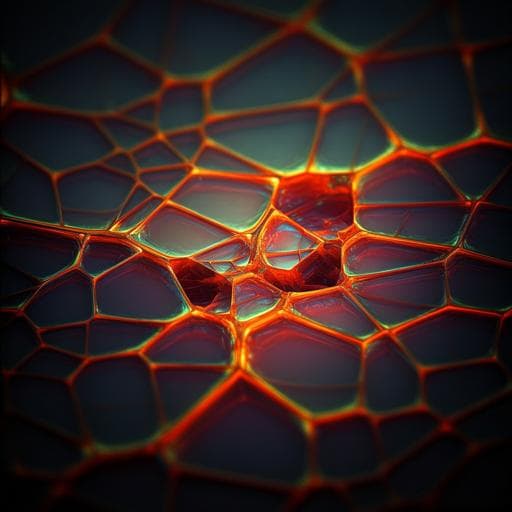
Engineering and Technology
Complexity of crack front geometry enhances toughness of brittle solids
X. Wei, C. Li, et al.
This groundbreaking study by Xinyue Wei, Chenzhuo Li, Cían McCarthy, and John M. Kolinski explores how complex crack front geometries enhance the toughness of brittle materials. By revealing a direct relationship between crack geodesic length and critical energy for crack propagation, the research challenges conventional fracture mechanics assumptions. Discover the implications of these findings for material modeling and engineering testing!
~3 min • Beginner • English
Introduction
The study investigates how three-dimensional crack front geometry influences the effective toughness of brittle solids. Traditional linear elastic fracture mechanics (LEFM) assumes planar cracks and uses stress intensity factors/energy release rates to predict crack growth, but real fracture surfaces in brittle materials are often corrugated or textured with features (lances, ridges, mist, hackle, microbranches, crack nets) that break planar symmetry. Existing 3D perturbation theories and path selection criteria are not applicable when cracks become strongly non-planar, and in situ 3D data on complex crack fronts have been scarce. The central question is whether and how geometric complexity of a crack front alters the critical strain energy release rate required for propagation. The authors use direct 3D imaging of crack tip kinematics and crack front geodesic length to relate loading conditions to geometry and assess implications for toughness and fracture theory.
Literature Review
Prior work establishes LEFM foundations for planar cracks (Williams 1957; Anderson 2017; Freund 1998) and Griffith’s energy balance approach. Empirically, fracture surfaces commonly exhibit non-planar features (lances, mist, hackle, microbranches, crack nets) that can arise from mixed-mode loading instabilities. While planar cracks often rely on ad hoc path criteria, no universally accepted 3D path selection criteria exist. Perturbative 3D crack front theories address small deviations but fail for large, complex front geometries. Experiments suggest step-like features can increase dissipation during crack propagation, yet comprehensive in situ 3D measurements for general crack front complexity have been lacking. These gaps motivate a direct measurement of 3D crack front geometry and energetics.
Methodology
- Materials: Transparent brittle polyacrylamide hydrogels of four chemistries (varying bis-acrylamide cross-linker concentrations: 2.67%, 1.87%, 0.81%, 0.35% for gels 1–4) and PDMS elastomer (Sylgard 184, 10:1) were prepared. Hydrogels were fluorescently labeled with Rhodamine 6G (post-polymerization dyeing) or Fluorescein o-acrylate (co-polymerized). PDMS was dyed with 0.1% TP-3400.
- Mechanical characterization: Uniaxial tension provided shear moduli for gels: 37.53, 13.07, 5.55, 3.12 kPa (gels 1–4), and PDMS: 0.323 MPa.
- Sample geometry and loading: Rectangular samples (approximately 3 × 1 cm; thicknesses primarily 190 µm, with 100 µm and 380 µm also used for gel 1) had an edge crack introduced about halfway across the width. Remote mode-I tensile loading was applied incrementally (<1% strain steps) in a water bath to match refractive index, using a custom symmetric servo-driven grip system on a confocal microscope stage. At each increment, the crack was allowed to equilibrate; volumetric image stacks were acquired until crack propagation and global failure occurred.
- Imaging: Inverted Leica DMi8 confocal microscope with HCPL Fluotar ×10 air or HC Fluotar ×25 water immersion objectives. Only the focal plane fluorescence was recorded; resonant-galvo or galvo-galvo scanning constructed raster images. 3D reconstructions around crack tips were generated from stacks.
- Crack geometry measurement: The crack front curve was extracted from volumetric reconstructions, and its geodesic length ℓ was computed. The normalized crack front length ξ (also denoted L in figures) was defined as ℓ/w, where w is sample thickness. Segmentation uncertainty for ξ was assessed via multiple processing parameter sets and manual segmentations (n = 31) after Gaussian filtering, thresholding, and morphological operations (using Imaris, Fiji, scikit-image). Profilometry of cast replicas (PVS) post-failure assessed surface roughness scales relative to confocal sectioning.
- CTOD and energy metrics: For each z-slice, the crack tip opening displacement (CTOD) profile was fit to a parabola x = −α y^2 as a function of evaluation window size W, yielding prefactor α. For incompressible materials, mode-I stress intensity factor K_I = 9π μ/(8 α), energy release rate G = K_I^2/(3 μ), and apparent fracture energy Γ_app = 3π μ/(8 α). Surfaces of Γ_app(z, W) were evaluated; the background value converged to G_c for each state.
- Analysis framework: Critical strain energy release rate G_c was plotted versus ξ to determine scaling. Energy partition model: total fracture energy Γ = Γ_pz + ∫ ds Γ′ ≈ Γ_pz + ξ Γ_tip, separating a geometry-insensitive process zone contribution (Γ_pz) and a crack-tip bond-breaking contribution scaling with crack front length (Γ_tip). Linear fits extracted Γ_pz and Γ_tip. Thickness effects and material dependence were evaluated across gels and PDMS. An additional experiment embedded rigid Nylon inclusions (50 µm diameter, 0.05 wt%) to induce crack plane symmetry breaking; CTOD fits excluded regions strongly perturbed by the inclusion.
- Subcritical evolution: Time series of crack front shapes during incremental loading were registered to examine partial/local advance along z prior to global propagation, and corresponding G and G_c values were tracked.
Key Findings
- Linear scaling of toughness with crack front length: The critical strain energy release rate G_c increases linearly with normalized geodesic crack front length ξ = ℓ/w across multiple brittle materials (four hydrogels and PDMS). For gel 1, G_c extrapolates to ≈ 4.9 J m−2 at ξ ≈ 1 (baseline fracture energy of a smooth crack).
- Energy partitioning explains scaling: The observed G_c(ξ) is substantially lower than the simple product of front length and baseline fracture energy would predict. A phenomenological partition Γ = Γ_pz + ξ Γ_tip fits the data, indicating a geometry-insensitive process zone contribution plus a crack-tip bond-scission contribution that scales with geodesic length. Prior independent measurements for gel 1 gave Γ_pz = 3.13 ± 0.44 J m−2 and Γ_tip = 1.77 ± 0.44 J m−2; linear fits to the present dataset yielded Γ_pz ≈ 3.81 J m−2 and Γ_tip ≈ 1.22 J m−2.
- CTOD-based energetics are consistent: Despite strong local variations in Γ_app near complex crack fronts, Γ_app(z, W) converges to a unique background value G_c for both simple and complex fronts when evaluated in the far field of the CTOD.
- Universality across materials and thickness: The proportional increase of normalized critical strain energy release rate with ξ holds for gels 1–4 and PDMS and shows no measurable dependence on sample thickness within the tested range.
- Fractional/local crack advance: Prior to global failure, cracks can advance locally along portions of the front while remaining globally stable (pinning over a narrow z-range), with the applied G rising to approach the critical boundary G_c(ξ) without exceeding it until catastrophic failure.
- Rigid inclusion induces symmetry breaking and toughening: Encountering a rigid Nylon particle breaks planar symmetry and increases front complexity; data before/after the inclusion fall on the same G_c–L line. The inclusion approximately doubles G and increases G_c by ~25%, demonstrating an engineering route to geometric toughening via elastic heterogeneity.
- Post-initiation smoothing: After initiation, cracks typically transition from complex to smooth fronts (ξ → 1) over a finite propagation distance, consistent with the observed stages on fracture surfaces.
Discussion
The findings directly address the central question of how 3D crack front geometry affects toughness: increasing the geodesic length of the crack front raises the critical strain energy release rate required for propagation. This implies materials can appear effectively tougher solely due to geometric complexity, even if intrinsic fracture properties remain unchanged. Partitioning fracture energy into a geometry-insensitive process zone and a crack-tip bond-breaking term that scales with front length rationalizes the observed linear trend and reconciles why simple scaling by front length alone overpredicts G_c.
The observation of fractional/local front advance prior to global failure suggests that, once planar symmetry is broken, the critical growth condition can become local along the front, challenging the classical LEFM view of a purely global singular-field criterion. Practically, the G–ℓ relationship acts as an attractor during loading, guiding subcritical evolution toward the global instability threshold.
These insights have implications for materials testing and design: non-planar initial crack fronts can cause overestimation of toughness if geometry is not accounted for; conversely, engineered heterogeneities (e.g., rigid inclusions) can purposefully increase front complexity and thus the effective toughness. The results point to the need for new 3D fracture theories capable of predicting how front geometry modifies energetics and path selection beyond small perturbations.
Conclusion
Direct 3D imaging of crack tip kinematics in hydrogels and PDMS shows that geometric complexity of the crack front enhances the effective toughness of brittle solids. The critical strain energy release rate scales linearly with the normalized geodesic crack front length when the process zone dissipation is accounted for. Additionally, cracks can advance fractionally along parts of the front while remaining globally stable, posing a challenge to conventional LEFM criteria.
The work provides a phenomenological framework (Γ = Γ_pz + ξ Γ_tip) connecting geometry to toughness and demonstrates an engineering route to toughening by inducing symmetry breaking with rigid inclusions. Future research should develop predictive 3D fracture theories for non-planar crack fronts, identify the physical (possibly local) growth criterion along the front, determine limits and potential saturation of geometric toughening, and assess the persistence of toughening under sustained loads and in broader classes of materials.
Limitations
- The phenomenological relation between G_c and geodesic length ξ was not tested against all possible geometric descriptors; other measures might capture aspects of complexity.
- Experiments were conducted on transparent hydrogels and PDMS proxies; generalization to opaque, stiffer, or more ductile engineering materials remains to be verified.
- Some datasets (gels 2–4 and PDMS with tiling) lack reported error bars on G_c due to acquisition constraints; segmentation-based uncertainty in ξ remains despite extensive controls.
- The underlying physical mechanism by which increased front length elevates G_c, and whether toughening saturates with complexity, are not yet established.
- The study focuses on quasi-static loading; persistence of geometric toughening under sustained or dynamic loading was not determined.
- The approach assumes the process zone scale is unaffected by front shape; deviations from this assumption in other materials or regimes could alter the energy partitioning.
Related Publications
Explore these studies to deepen your understanding of the subject.







